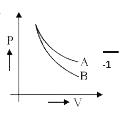The equation of state for a gas is given by PV=ηRT+αV, where η is the number of moles and α a positive constant. The intinal pressure and temperature of 1 mol of the gas contained in a cylinder is P0 and T0, respectively. The work done by the gas when its temperature doubles isobarically will be
P0T0RP0−α
P0T0RP0+α
P0T0R 1n 2
none of these
The correct Answer is:A
To solve the problem, we need to find the work done by the gas during an isobaric process when its temperature doubles. Let's break down the solution step by step.
Step 1: Understand the Work Done in an Isobaric Process
The work done (W) by a gas during an isobaric process is given by the formula:
W=PΔV
where P is the constant pressure and ΔV is the change in volume.
Step 2: Use the Given Equation of State
The equation of state for the gas is given by:
PV=ηRT+αV
where η is the number of moles, R is the universal gas constant, α is a positive constant, and V is the volume.
Step 3: Rearranging the Equation
We can rearrange the equation to express pressure P:
P=ηRT+αVV
This can be simplified to:
P=ηRVT+α
Step 4: Determine the Change in Volume
When the temperature doubles (from T0 to 2T0), we need to find the change in volume ΔV. The change in temperature ΔT is:
ΔT=2T0−T0=T0
Step 5: Express ΔV in Terms of P and α
From the equation of state, we can express the change in volume:
PΔV=ηRΔT+αΔV
Rearranging gives:
PΔV−αΔV=ηRΔT
Factoring out ΔV:
ΔV(P−α)=ηRΔT
Thus,
ΔV=ηRΔTP−α
Step 6: Substitute Values
Substituting ΔT=T0 and η=1 (since we have 1 mole of gas):
ΔV=RT0P−α
Step 7: Substitute ΔV into Work Done Formula
Now substituting ΔV back into the work done formula:
W=PΔV=P(RT0P−α)
This simplifies to:
W=PRT0P−α
Final Answer
Thus, the work done by the gas when its temperature doubles is:
W=P0RT0P0−α
The work done (W) by a gas during an isobaric process is given by the formula:
W=PΔV
where P is the constant pressure and ΔV is the change in volume.
The equation of state for the gas is given by:
PV=ηRT+αV
where η is the number of moles, R is the universal gas constant, α is a positive constant, and V is the volume.
We can rearrange the equation to express pressure P:
P=ηRT+αVV
This can be simplified to:
P=ηRVT+α
When the temperature doubles (from T0 to 2T0), we need to find the change in volume ΔV. The change in temperature ΔT is:
ΔT=2T0−T0=T0
From the equation of state, we can express the change in volume:
PΔV=ηRΔT+αΔV
Rearranging gives:
PΔV−αΔV=ηRΔT
Factoring out ΔV:
ΔV(P−α)=ηRΔT
Thus,
ΔV=ηRΔTP−α
Substituting ΔT=T0 and η=1 (since we have 1 mole of gas):
ΔV=RT0P−α
Now substituting ΔV back into the work done formula:
W=PΔV=P(RT0P−α)
This simplifies to:
W=PRT0P−α
Thus, the work done by the gas when its temperature doubles is:
W=P0RT0P0−α
Topper's Solved these Questions
- BOOK - CENGAGE PHYSICS ENGLISHCHAPTER - KINETIC THEORY OF GASES AND FIRST LAW OF THERMODYNAMICSEXERCISE - Multiple Corrects29videos
KINETIC THEORY OF GASES AND FIRST LAW OF THERMODYNAMICS
- BOOK - CENGAGE PHYSICS ENGLISHCHAPTER - KINETIC THEORY OF GASES AND FIRST LAW OF THERMODYNAMICSEXERCISE - Assertion-Reasoning6videos
KINETIC THEORY OF GASES AND FIRST LAW OF THERMODYNAMICS
- BOOK - CENGAGE PHYSICS ENGLISHCHAPTER - KINETIC THEORY OF GASES AND FIRST LAW OF THERMODYNAMICSEXERCISE - Subjective22videos
KINETIC THEORY OF GASES AND FIRST LAW OF THERMODYNAMICS
- BOOK - CENGAGE PHYSICS ENGLISHCHAPTER - KINETIC THEORY OF GASESEXERCISE - Compression2videos
KINETIC THEORY OF GASES
- BOOK - CENGAGE PHYSICS ENGLISHCHAPTER - LINEAR AND ANGULAR SIMPLE HARMONIC MOTIONEXERCISE - Single correct anwer type14videos
LINEAR AND ANGULAR SIMPLE HARMONIC MOTION
Similar Questions
Knowledge Check
- Question 1 - Select One
For an ideal gas, number of moles per litre in terms of its pressure P, gas constant R and temperature T is
APT / RBP / RTCPRTDRT / P
One mole of an ideal gas at temperature T expands slowly according to the law pV= constant.
Its final temperature is T2. The work done by the gas isView SolutionOne mole of an ideal gas at temperature T expands slowly according to the law pV= constant.
Its final temperature is T2. The work done by the gas isView SolutionOne mole of an ideal gas at temperature T expands slowly according to the law pV= constant.
Its final temperature is T2. The work done by the gas isView SolutionThe equation of state of a real gas is given by (P+aV2)(V−b)=RT
where P, V and T are pressure, volume and temperature resperature and R is the universal gas constant. The dimensions of the constant a in the above equation isView SolutionTen moles of a diatomic perfect gas are allowed to expand at constant pressure. The initial volume and temperature are V0 and T0 respectively. If 72RT0 heat is transferred to the gas, then the final volume and temperature are
View SolutionThe equation of state of a gas is given as P(V-b)=nRT, where b is constant ,n is the number of moles and R is the universal gas constant .when 2 moles of this gas undergo reversible isothermal expansion from volume V to 2V ,what is work done by the gas ?
View SolutionOne mole of a gas is heated at constant pressure to raise its temperature by 1∘C. The work done in joules is
View Solution


